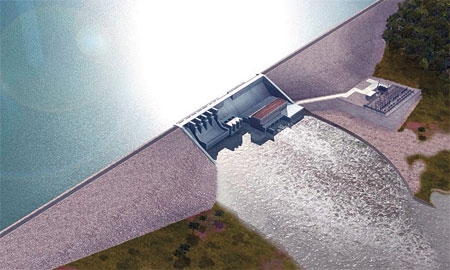In Cameroon, the overall hydropower potential is estimated at 13,000MW. As of 2011, only 721MW of energy produced domestically was generated at hydroelectric plants. Lom Pangar Hydropower Project (LPHP) is therefore considered a centrepiece of the Government’s Growth and Employment Strategy Paper (GESP) and Vision 2035.
When LPHP goes online in 2014, dividends will begin to cascade into the real economy. The dam’s hydropower station will provide low-cost access to 6,000MW, thus bolstering GDP growth. Cash returns are likely to be reinvested in other productive sectors of the economy. In the long term, the project can help bring down electricity tariffs for low and medium-voltage consumers.
Beyond its engineering aspects, however, LPHP is likely to trigger further investments into hydropower infrastructure. For policymakers it is also a tool to improve industrial productivity. Factories and mineral treatment facilities will be able to invest in capital goods given the additional electricity supply. This will lead to a significant decrease in poverty indicators. As of 2007, 39.9 per cent of Cameroonians lived below the poverty threshold.
“In the first year of implementation, the GESP has already made important gains. We have good reason to be optimistic about reaching our long-term vision. The Government’s approach is multi-tiered, but includes improving the level of energy production so that industry can work at full capacity,” says Minister of Economy, Planning and Regional Development Louis-Paul Motaze.
In terms of long-run economic impact, electricity outages since 1995 have shaved an average of 1-2 per cent of GDP growth each year. Power shortages have also driven up the cost of access to electricity for end consumers as AES-Sonel, the public utility, was forced to redistribute scant resources to industrial players. This has, in turn, stunted the expansion of the power grid into rural areas.
According to Government studies published in 2010, a delay in implementing energy megaprojects like LPHP would cost the economy 0.5 per cent in GDP growth per year or 5 per cent through to 2020. In terms of public finances, losses from non-oil sector receipts would amount to CFA 60 billion (£79.9 million) per year. This would be devastating for the economy and for business conditions.
“The energy sector will contribute in no small way to improving the business environment in Cameroon. It is clear to everyone that industries rely heavily on power provision. Any investor setting up shop in this country will want to make sure that access to electricity is reliable and effective. That is what makes Lom Pangar such a critical project as we work toward becoming an emerging market,” says Mr Motaze.
Lom Pangar Hydropower Project fact sheet.
• A larger share of hydropower generation capacity will lower power costs, improving productivity and competitiveness for the private sector.
• The LPHP is the basis to trigger the next wave of investments in hydropower on the Sanaga River. A series of planned industrial, mining, and business projects depend on expanded electricity.
• The LPHP presents equity, social, and environmental challenges that must be managed according to international standards.
• The reservoir created by the Lom Pangar project will require rebuilding of two stretches of the Chad Cameroon oil pipeline. The government of Cameroon and the Cameroon Oil Transportation Company (COTCO), based on technical studies already completed, will manage the work.
• To manage the risk of an oil spill into the reservoir, COTCO will develop a Specific Area Oil Spill Response Plan and the National Hydrocarbons Society will update the National Oil Spill Plan. Together with IFC, the World Bank will ensure that adaptation work will conform to World Bank Group environmental and social standards.
• An estimated 255 households would require resettlement as a result of the project reservoir.
• The Wildlife Conservation Society is providing technical assistance to the government on the creation of the park, building on its recent inventory of the primates that live there. The creation of the Deng Deng National Park as biodiversity offset for the LPHP significantly increase security for the primates.
• World Bank support to the Lom Pangar Hydropower Project is conditional upon ongoing conformity of project preparations with the agreed implementation framework.

1 COMMENT
Lets hope the Lom Pangar Dam Environmental Protection Plans are approved quicker than the mainline safety plans because it took NINE (9) years for the World Bank and Exxon to produce those plans. The Chad Pipeline is a boondoogle and a health and safety TIMEBOMB.